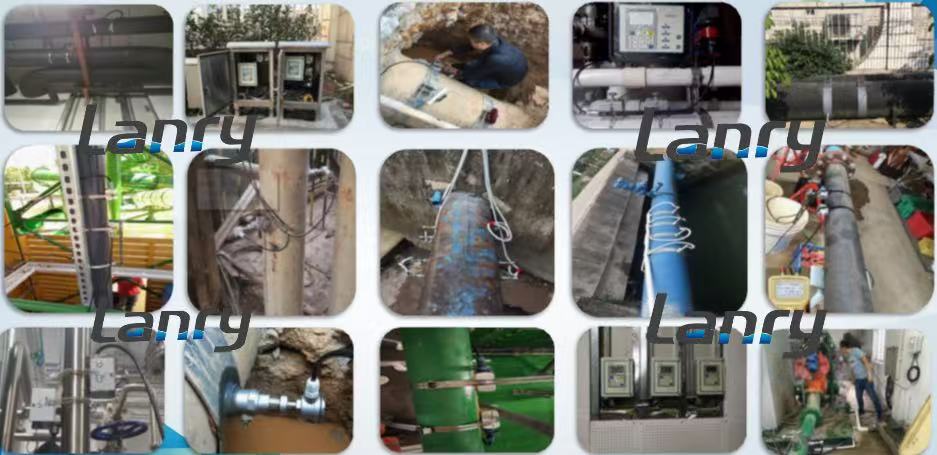1. High Measurement Accuracy
Ultrasonic flowmeters are capable of providing extremely accurate flow rate measurements. The time - difference principle, which is commonly used in many ultrasonic flowmeters, allows for precise determination of the fluid's velocity. By accurately measuring the time it takes for ultrasonic waves to travel upstream and downstream in a flowing fluid, the flow velocity can be calculated with great precision. For example, in applications where exact dosing of chemicals is required, such as in the pharmaceutical industry, the high accuracy of ultrasonic flowmeters ensures that the right amount of ingredients is mixed, leading to consistent product quality. Some advanced ultrasonic flowmeters can achieve an accuracy of up to ±0.5% of the measured value, which is significantly better than many other flowmeter types.
2. Non - Intrusive Measurement
One of the most significant advantages of ultrasonic flowmeters is their non - intrusive nature. In contrast to traditional flowmeters like orifice plates or turbine flowmeters that require insertion into the fluid stream, ultrasonic flowmeters can be installed on the outer surface of the pipeline. This non - intrusive installation method has several benefits. Firstly, it does not disrupt the flow profile of the fluid, which means there is no additional pressure drop in the pipeline. This is crucial in applications where maintaining a certain pressure level is essential, such as in oil and gas pipelines. Secondly, it reduces the risk of contamination of the fluid, as there are no parts of the flowmeter in contact with the fluid. This makes ultrasonic flowmeters suitable for measuring the flow of highly pure or sensitive fluids, like ultrapure water in the semiconductor industry.
3. Wide Range of Applicable Fluids
Ultrasonic flowmeters can be used to measure the flow of various types of fluids, including liquids, gases, and even some slurries. For liquids, they work effectively regardless of whether the liquid is clean water or a viscous liquid with additives. In the food and beverage industry, ultrasonic flowmeters can measure the flow of juices, syrups, and even beer during the production process. When it comes to gases, ultrasonic flowmeters can accurately measure the flow of natural gas, air, or industrial gases. Even in applications involving slurries, such as in mining where the flow of ore - bearing slurries needs to be measured, ultrasonic flowmeters can provide reliable flow data. Their ability to adapt to different fluid properties makes them a versatile choice for flow measurement.
4. High Turndown Ratio
The turndown ratio is an important parameter in flow measurement, representing the ratio between the maximum and minimum flow rates that a flowmeter can accurately measure. Ultrasonic flowmeters typically offer a high turndown ratio, often in the range of 100:1 or even higher. This means they can accurately measure both very low and very high flow rates within the same installation. For example, in a water supply system, the flow rate can vary significantly depending on the time of day and the demand. An ultrasonic flowmeter installed in the main water pipeline can accurately measure the low flow during the night when consumption is minimal and the high flow during peak usage hours, providing comprehensive and accurate flow data for efficient water management.
5. Low Maintenance Requirements
Ultrasonic flowmeters generally have fewer moving parts compared to some traditional flowmeter designs. With no mechanical components such as rotors or vanes that are subject to wear and tear from the flowing fluid, they require less maintenance. The transducers, which are the main components of ultrasonic flowmeters, are usually durable and can operate for long periods without the need for frequent replacement. In industrial settings where continuous operation is crucial, the low maintenance requirement of ultrasonic flowmeters reduces downtime and maintenance costs. For instance, in a large - scale chemical plant, the use of ultrasonic flowmeters can minimize the need for regular maintenance shutdowns, ensuring uninterrupted production and higher overall efficiency.
6. Remote Monitoring and Communication Capabilities
Modern ultrasonic flowmeters are often equipped with advanced communication interfaces, such as RS - 485, Modbus, or wireless communication options like Wi - Fi or Bluetooth. This enables easy integration with remote monitoring systems and control networks. Operators can access real - time flow data from a central control room, even if the flowmeter is installed in a remote location. In a large - scale oil and gas pipeline network that spans across different geographical areas, engineers can monitor the flow rate of oil or gas at various points along the pipeline using ultrasonic flowmeters with remote communication capabilities. This not only improves the efficiency of pipeline management but also allows for quick response to any changes in flow rates, such as detecting leaks or abnormal flow patterns in a timely manner.
In conclusion, ultrasonic flowmeters offer a plethora of advantages in flow measurement, including high accuracy, non - intrusive operation, wide fluid applicability, high turndown ratio, low maintenance, and excellent remote monitoring capabilities. These advantages make them an ideal choice for a vast array of industries, from manufacturing and energy to healthcare and environmental monitoring, driving more accurate and efficient flow - related processes.

Post time: Feb-18-2025

